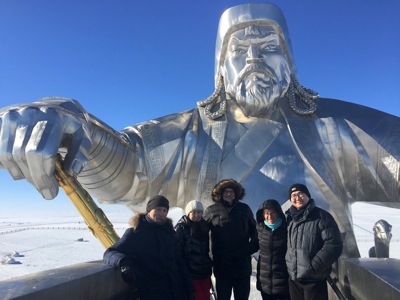Wednesday, May 31st, 2017
Local couple warms up to Rotarians' humanitarian project slated for Mongolia
By William Kincaid

Submitted Photo
Gary Newton, center, and his wife, Debbie, stand atop a giant Genghis Khan statue in Mongolia in early January as part of a Rotary project. Rotary District 6600 officials hope to install the first childbirth simulation center to Mongolia next year.
CELINA - A St. Marys couple representing Rotary District 6600 earlier this year braved Mongolia's freezing temperatures and rugged terrain ahead of a proposed major humanitarian project.
Gary Newton, the past district governor, along with his wife, Debbie Newton, and Pat Serio of Oberlin, both certified nurse midwives, in late January flew to the capital, Ulaanbaatar, to meet health officials.
Rotary District 6600 encompasses 64 Rotary clubs in northwest Ohio, including Celina's, St. Marys' and New Bremen's. District officials want to help set up Mongolia's first childbirth simulation centers to train doctors, midwives and nurses.
They also want to send a vocational training team consisting of four American midwives to Mongolia to raise the midwifery standards in the country, according to Gary Newton, who spoke to Celina Rotarians on Tuesday afternoon.
"The vast number of low-risk births in the country are performed by midwives," Newton told the newspaper. "Sharing U.S. standards and techniques with midwives, particularly those involved in training others, will improve results in all births."
Moreover, the district wants to have four Mongolian midwives visit this area to "explore simulation center training and midwifery practices in the U.S."
But first, district officials wanted to make face-to-face contact with Mongolian health officials.
"This trip was more or less a relationship-building and kind of a scouting, informational trip, because we just couldn't envision what a hospital in Mongolia looked like," Gary Newton told Rotarians.
The Newtons and Pat Serio were greeted warmly by both health officials and members of one of Mongolia's 17 Rotary clubs.
The group visited numerous sites in the capital including its two large hospitals. The city is home to 1.3 million of the country's 3 million people.
"The proposed (Rotary) grant would establish a state-of-the-art childbirth simulation center in the capital city of Ulaanbaatar," Gary Newton wrote. "Over 40 percent of the country's population lives in Ulaanbaatar. Of the approximately 79,000 births accruing annually in Mongolia, 26,000 take place at two larger maternity hospitals in Ulaanbaatar."
A childbirth simulation center allows for health providers to train for problems during childbirth, such as excessive bleeding and high blood pressure, Gary Newton explained.
District club officials would like to have the center installed at a health-development center so it could be used by personnel from both hospitals, a university and health-care providers from 21 provincial hospitals, Gary Newton said.
"The center would train OB/GYNs, midwives, pediatricians and nurses in a team approach to better handle problem births," he said.
To pay for the childbirth simulation center and midwife exchange - together estimated at $200,000 - district 6600 is seeking $63,000 in contributions from its clubs. Matching dollars would come from district and Rotary Foundation funds, he said.
The grant focuses on maternal and child health, one of Rotary's six areas of focus, he added.
Newton also revealed details of his visit to Mongolia, which he said was a "little chilly" with temperatures ranging from minus-25 to minus-40 degrees, not counting wind chill. In fact, Ulaanbaatar is the coldest capital in the world with an average temperature of 29 degrees, he said.
Mongolia is the 18th largest sovereign nation but is sparsely populated with 3 million people, just a little more than the population of Utah. With Russia to the north and China to the South, Mongolia is landlocked, he said.
"Genghis Khan first brought the Mongolian Empire together in 1206, and it became the largest contiguous land empire in the history of the world. It stretched from China to Europe," Gary Newton said.
Today, Khan remains the national hero, his image emblazoned on currency and his likeness seen in countless monuments and statues.
The country came under Chinese rule in the 1600s before briefly gaining independence in 1911 and later becoming a Soviet satellite state in 1924.
"You see a lot of that Soviet influence in the country today in their architecture," he said. "The people running things now were actually brought up under the Soviet system, so they're kind of bureaucratic types. Younger people are not that way. They're much more open."
After the collapse of the Soviet Union, Mongolia became a sovereign state, he said.
Known as The Land of Eternal Blue Sky because of its 250 sunny days every year, Mongolia today is a major exporter of natural resources such as copper and coal, he said.


